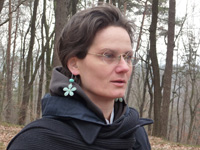The OHO Files, Updated

In October 2011, ARTMargins Online published a block of texts on the Slovene art collective the OHO Group, including interviews with Milenko Matanovi? and David Nez. The texts were accompanied by an afterword by Ksenya Gursthein. We are now adding interviews with OHO members Marko Poga?nik and Andraž Šalamun, together with an updated preface.
The OHO Group, a Slovene artistic collective formed in the late 1960s, consisted of Milenko Matanovi?, David Nez, Marko Poga?nik, and Andraž Šalamun as the permanent, core members. Other artists, for example, Tomaž Šalamun, who is well known as a poet today, often contributed or acted as part of the group. The OHO Group belonged to a wider Slovene intellectual and artistic circle called the OHO Movement and regularly collaborated with its members.
The OHO Group achieved success in the late 1960s and early 1970s by participating in conceptual art exhibitions both at home and abroad. Their artistic practice was very versatile; in their early work we can see connections to Arte Povera, Land art, happenings, and different body art practices. While working together, the members of the collective increasingly realized that they were interested in exploring spirituality and in transferring spiritual issues into their art practice. They became interested in ritual as a medium; this made it possible to transcend the boundaries of the everyday world and to establish a deeper connection with nature.
In their next phase, the members of the OHO group gave up working in the art system and founded a commune in the village of Šempas, in the Vipava Valley, Slovenia, because they wanted to establish a more intense closeness to nature and work as a group in harmony with the environment and the cosmos. Their art activity did not cease in this new setting, but rather became more directly connected to their day-to-day lives.

Soon, Marko Poga?nik and his family were the only ones left in the commune. They were joined, however, by new members. Calling themselves “the Šempas Family,” the members of this commune worked on developing a new form of total spirituality and an alternative relationship to the planet Earth and nature. From time to time, the Šempas Family would also show their work in the context of the institutional art world.
David Nez, Milenko Matanovi?, and Marko Poga?nik are all still actively working in this direction today. They all found ways to instill awareness about the importance of the spiritual and ritualistic dimensions of human existence into their own life practices, which, although still closely involved with art, are now primarily concerned with working with and for communities. Matanovi?, who now lives in the United States, runs the Pomegranate Center, which he founded. The center undertakes a number of different tasks, but primarily it helps urban neighborhoods and other communities plan and build common gathering areas where they can begin to live more intensively as communities and perform their own rituals and ceremonies. Nez also works in the United States, in the mental health field as an art therapist in the state of Oregon. He regularly includes ritualistic elements in his professional practice. Poga?nik, meanwhile, has developed a special method for healing urban and rural spaces, which he calls lithopuncture. In conjunction with this, he has also developed forms of comprehending and harmonizing the geomantic dimensions of these spaces.
Today the OHO Group’s legacy continues as a crucial reference for Slovene contemporary art. In recent years a slight trend of reactualization of the group can be observed and finds expression in texts, events and exhibitions.(OHO; Retrospektiva / A Retrospective, ed. Igor Zabel, Ljubljana: Moderna galerija 1994 (second, expanded edition 2007). Igor Zabel, A Short History of OHO, East Art Map; Contemporary Art and Eastern Europe, ed. IRWIN, London: Afterall 2006, pp. 410-432. Miško Šuvakovi?, The Clandestine Histories of the OHO Group, Ljubljana: Zavod P.A.R.A.S.I.T.E. 2010. Dogodek / The Event; 29. grafični bienale / The 29th Biennial of Graphic Arts, ed. Peter Kisin, Beti Žerovc, Ljubljana: Mednarodni grafični likovni center 2011, pp. 182-193. Marko Poga?nik; Umetnost življenja – življenje umetnosti / The Art of Life – The Life of Art, ed. Igor Španjol, Ljubljana: Moderna galerija 2012.) The OHO Group’s work is also currently the subject of some substantial projects of artistic reenactment.(Among others: IRWIN, Birds of a Feather (IRWIN – OHO), 1985; IRWIN, Like to Like, 2004; Janez Janša, Janez Janša, Janez Janša, Mt Triglav on Mt Triglav, 2007; Janez Janša, Life [in Progress], 2008 Ljubljana. During the theater performance Life [in Progress] viewers were invited to reenact the Matanovi? piece Mt Triglav. See also Milena Tomi?, Re-enacting OHO; some interventions in a neo-avant-garde field, Object (London), 14, 2012, pp. 100-125.) A major Slovene prize for young artists has been named after the group.
The interviews that follow were carried out from the premise that the critical literature about the group is still rather scarce, and that what there is lacks clarity. Also, there is little reliable information about what happened with the OHO Group’s members after they ceased to work together as artistis.
Editor’s note: The interviews were conducted with each member of the group individually, but they contain similar questions. The interviewed artists were all asked to relate the history of OHO chronologically, from the beginning of their joint work to the present day. Matanovi? and Nez were also asked explicitly to reveal as much as possible about their lives in the post-OHO period; both have not been present in Slovenia since the beginning of the 1970s, and almost nothing is known about their post-OHO lives. Because David Nez is an American who has spent only a few years in Slovenia and never really spoke Slovenian, this topic was also discussed.




